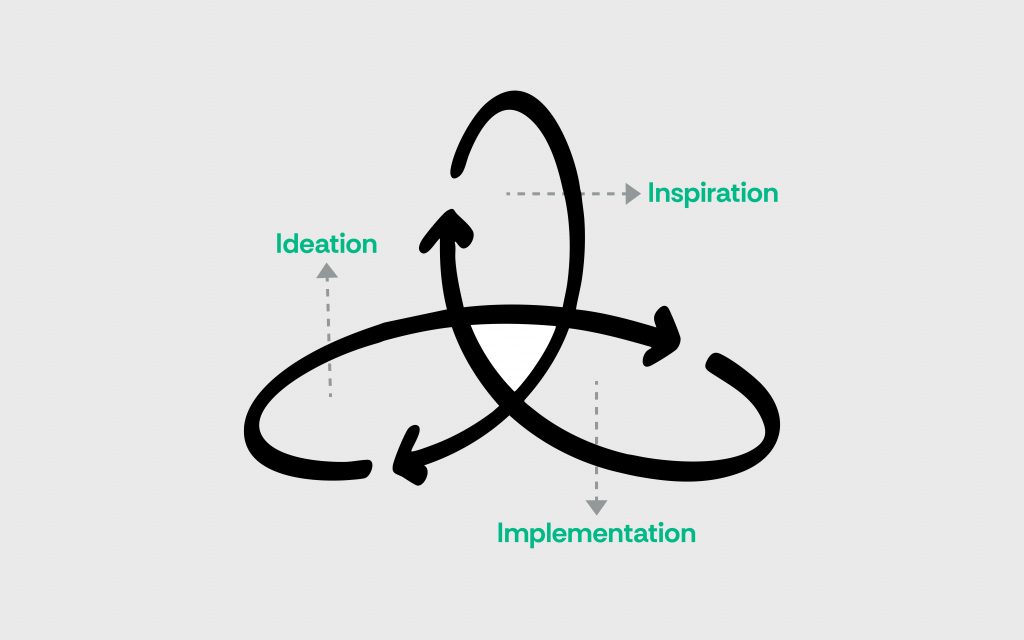Design Thinking: More Than a Process, It’s a Way of Seeing
In past reflections on UX, we’ve explored microinteractions, emotional design, and even the ethics behind dark patterns. But when it comes to tackling problems that aren’t fully understood yet, there’s a mindset that often comes into play before any screen is designed or any journey is mapped: Design Thinking.
It’s not a trend. It’s not just a process. It’s a flexible, user-focused approach that helps uncover insights, reframe challenges, and explore possibilities. While commonly used in UX and product teams, it has become a core practice across innovation, business strategy, social design, and beyond.
Design Thinking as a Flexible Framework
Often summarized into five stages—Empathize, Define, Ideate, Prototype, and Test—Design Thinking is mistakenly viewed as a checklist. In practice, these stages are not always sequential.
They’re interconnected, and teams often loop back and forth—testing early, reframing problems mid-way, or even returning to the empathy stage after testing reveals new insights.Each phase holds space for curiosity, but also encourages tangibility. Even vague ideas are turned into real, testable prototypes, allowing teams to learn through doing rather than theorising.
An Alternative View: IDEO’s Three Activities
While the five-stage model is widely used, IDEO, a leading voice in design innovation, presents an alternate framing that emphasizes how projects naturally cycle, overlap, and inform one another.
Their model organizes the process into three interconnected activities:
Inspiration – identifying a compelling challenge or user need
Ideation – generating ideas and exploring possible solutions
Implementation – testing, refining, and scaling the ideasThis perspective reinforces the idea that Design
Thinking is not linear. Instead, it’s fluid, iterative, and responsive—shaped by discovery, shaped again through making, and continuously refined through feedback.

Why Design Thinking Isn’t Just for Designers
One of the biggest misconceptions is that Design Thinking is limited to creatives. Yet, it’s been used by:
- Tech companies building human-centered AI products
- Healthcare teams improving patient journeys
- NGOs redesigning community services
- Businesses solving system-level friction in customer experience
The reason it works? Because it focuses not just on solving problems, but understanding the people behind them.
Key Principles That Make It Work
Empathy First
Solutions that last are rarely created in isolation. Design Thinking begins by deeply understanding users’ emotions, context, and challenges, which are often hidden beneath surface-level needs.
Reframing Before Solving
Rather than jumping into solutions, Design Thinking encourages teams to redefine the problem. Often, what seems like a usability issue turns out to be a misaligned goal, a broken system, or a gap in communication.
Ideation Without Judgment
Brainstorming isn’t about wild ideas for their own sake. It’s about creating enough range so the team doesn’t settle too soon. Even what sounds impractical might inspire a new approach.
Prototyping as a Thinking Tool
Instead of endless debate, teams are encouraged to build something early—even if it’s rough. Prototypes allow teams to think through problems more clearly and adjust faster.
Feedback as Fuel
Testing doesn’t wait until the “end.” It’s embedded in the process. Failures aren’t feared—they’re used to guide smarter iterations.
A Culture, Not Just a Methodology
What makes Design Thinking powerful isn’t just the framework—it’s the mindset it builds within teams.
- Silos are broken.
- Assumptions are questioned.
- Users are brought into the room early—not just at launch.
It enables a culture where collaboration, experimentation, and empathy are practiced regularly—not reserved for special projects.
Design Thinking doesn’t promise perfect solutions. It offers a better way to arrive at meaningful ones—especially when challenges are complex and human needs are nuanced.
As digital professionals, we know that tools and methods evolve. But the ability to think deeply, test quickly, and keep users at the center remains timeless.
In a world filled with assumptions, Design Thinking reminds us to ask better questions—because when we do, better answers usually follow.

13 comments
pharmacies américaines pour kamagra sans rx
August 17, 2025 at 9:24 amacheter kamagra en ligne sans ordonnance
medicament kamagra pharmacie gratuit pilules
order enclomiphene australia no prescription
August 17, 2025 at 10:03 amcheap enclomiphene where to purchase
how to buy enclomiphene canadian pharmacy no prescription
buying androxal generic pharmacy online
August 17, 2025 at 10:19 amandroxal no rx cod
purchase androxal generic canadian
ordering dutasteride new zealand buy online
August 17, 2025 at 11:37 ambuy cheap dutasteride generic form
how to buy dutasteride buy in london
cheapest buy flexeril cyclobenzaprine canada price
August 17, 2025 at 1:22 pmbuy cheap flexeril cyclobenzaprine cheap from india
buying flexeril cyclobenzaprine cheap sale
buying gabapentin price australia
August 17, 2025 at 2:00 pmonline order gabapentin generic for sale
buy cheap gabapentin cheap no prescription
online order fildena australia to buy
August 17, 2025 at 4:05 pmcheapest buy fildena cheap from canada
online order fildena cost at costco
ordering itraconazole cost tablet
August 18, 2025 at 2:30 amget itraconazole cheap drugs
purchase itraconazole canadian pharmacy no prescription
compare prices generic staxyn online without prescription
August 18, 2025 at 2:33 amdiscount staxyn overnight no rx
discount staxyn cheap canada
how to buy avodart purchase online canada
August 18, 2025 at 4:20 amdiscount avodart cheap online no prescription
buying avodart usa sales
how to order rifaximin low cost
August 18, 2025 at 5:23 amdiscount rifaximin generic health
order rifaximin price discount
xifaxan cheap no membership
August 18, 2025 at 6:18 ambuy xifaxan price by pharmacy
ordering xifaxan generic where to buy
koupě kamagra bez rx
August 18, 2025 at 9:45 amkamagra cena
bez lékařského předpisu levné kamagra
Comments are closed.